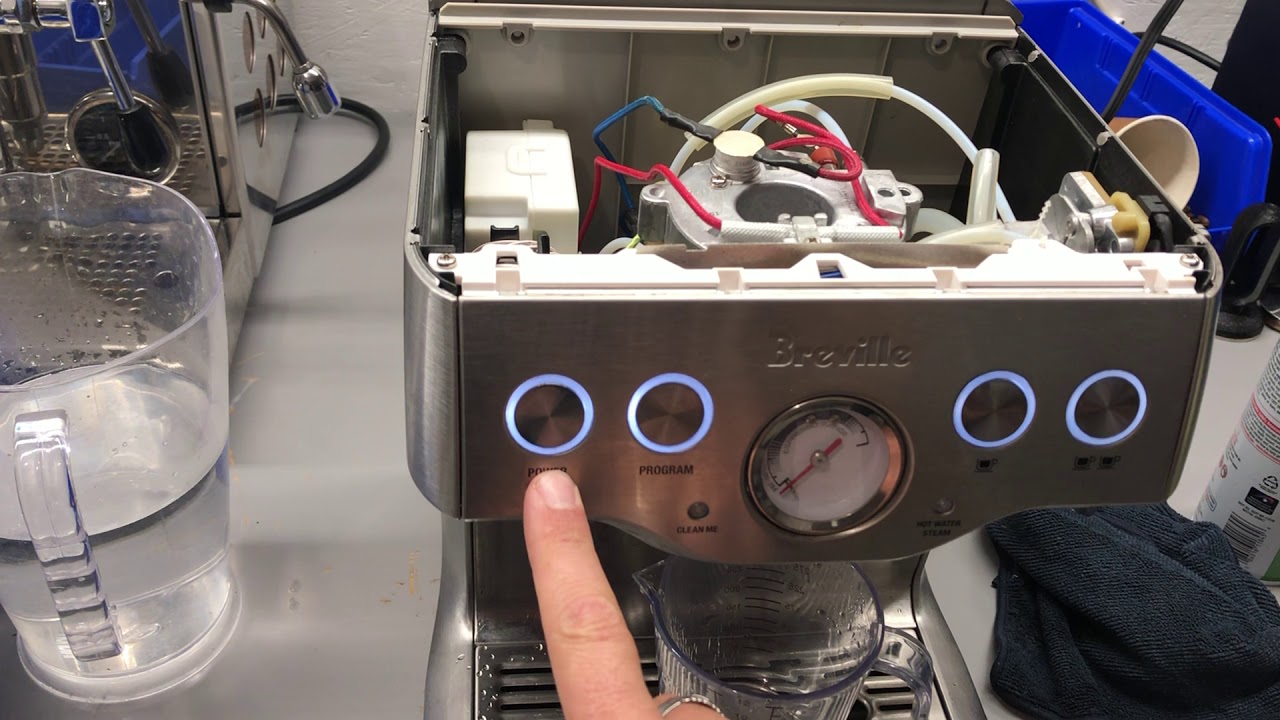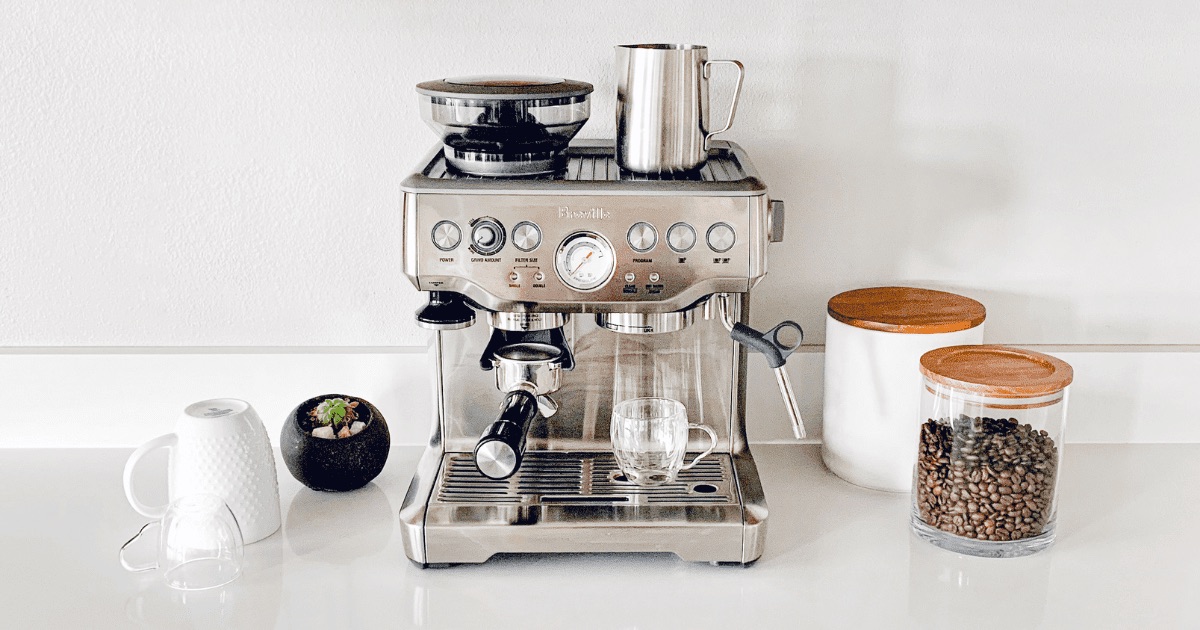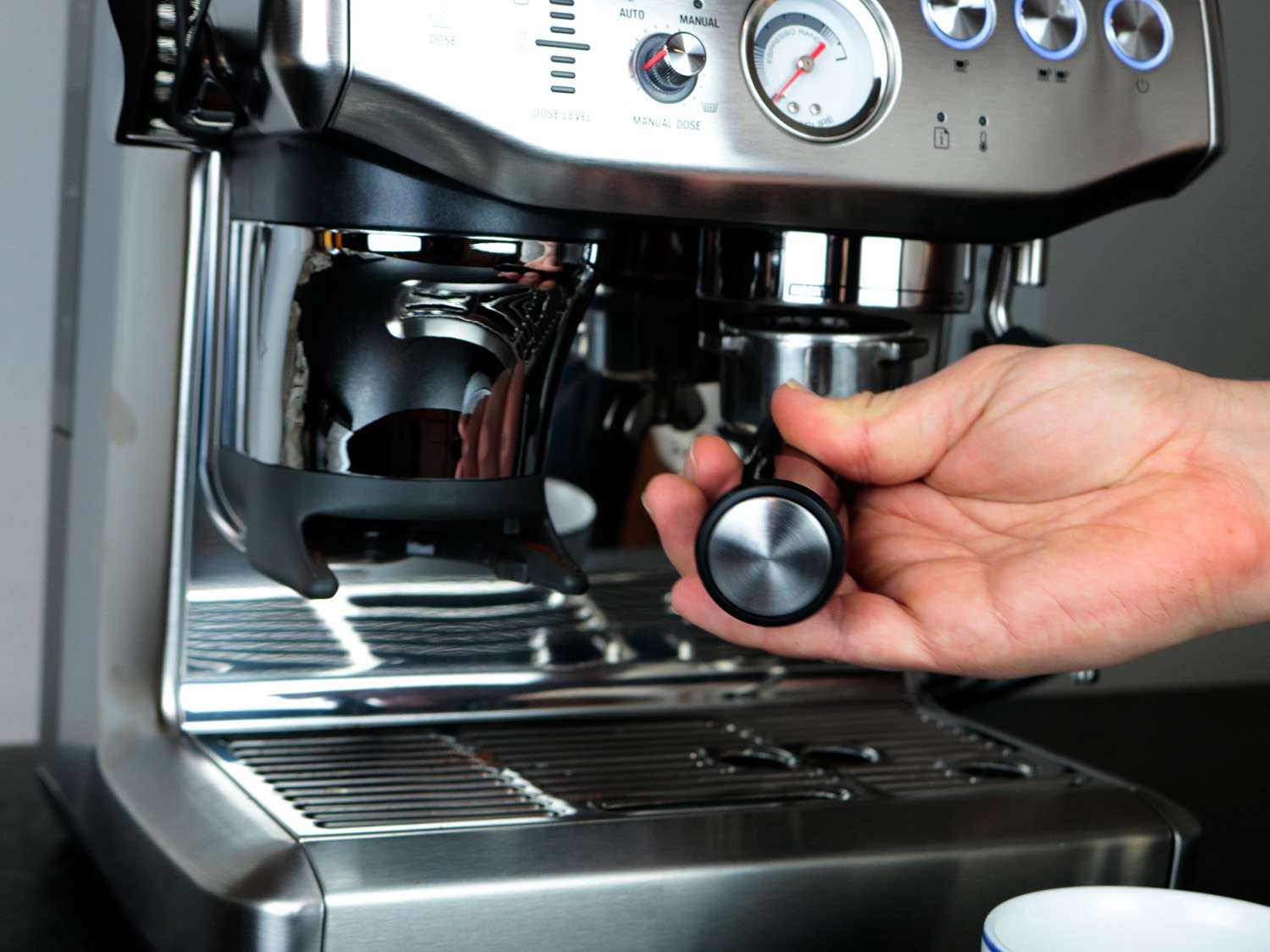Home>Home Appliances>Kitchen Appliances>How To Fix The Breville Espresso Machine


Kitchen Appliances
How To Fix The Breville Espresso Machine
Modified: October 30, 2024
Learn how to troubleshoot and repair your Breville espresso machine with expert tips and guidance. Get your kitchen appliances working perfectly again!
(Many of the links in this article redirect to a specific reviewed product. Your purchase of these products through affiliate links helps to generate commission for Storables.com, at no extra cost. Learn more)
Introduction
So, you've been looking forward to enjoying a rich, aromatic cup of espresso from your Breville espresso machine, only to find that it's not functioning as it should. Don't worry; you're not alone. Many espresso enthusiasts encounter issues with their machines, but the good news is that most problems can be fixed with a little know-how and the right tools.
In this comprehensive guide, we'll delve into the world of Breville espresso machines, exploring common issues and providing step-by-step instructions on how to troubleshoot and fix them. Whether you're dealing with a clogged portafilter, a malfunctioning steam wand, or an inconsistent water flow, we've got you covered.
By the end of this article, you'll feel confident in your ability to diagnose and repair your Breville espresso machine, saving you time and money on professional repairs. So, roll up your sleeves, gather your tools, and let's get started on reviving your beloved espresso machine.
Key Takeaways:
- Keep your Breville espresso machine running smoothly by regularly cleaning the group head, descaling the machine, and checking for leakages to ensure consistent and flavorful espresso every time.
- Familiarize yourself with your Breville espresso machine’s components and unique features to confidently troubleshoot and fix common issues, saving time and money on professional repairs.
Read more: How To Use The Breville Espresso Machine
Understanding the Breville Espresso Machine
Before delving into the troubleshooting process, it's essential to have a basic understanding of how the Breville espresso machine operates. Breville is renowned for producing high-quality espresso machines that are designed to deliver exceptional coffee experiences. These machines are equipped with advanced features such as precise temperature control, optimal pressure for extraction, and customizable settings to cater to individual preferences.
The Breville espresso machine typically consists of a water reservoir, a portafilter, a group head, a steam wand, and various control buttons or dials. The water reservoir stores the water used for brewing espresso, while the portafilter is where the ground coffee is placed for extraction. The group head is the component that delivers hot water to the coffee grounds, and the steam wand is used to froth milk for beverages like lattes and cappuccinos.
Understanding the key components and their functions is crucial for diagnosing and resolving issues with the machine. Whether it's a leaky steam wand, a lack of water flow, or inconsistent pressure during extraction, having a grasp of how each part contributes to the espresso-making process will empower you to effectively troubleshoot and repair the machine.
Furthermore, familiarizing yourself with the specific model of your Breville espresso machine and its unique features will aid in identifying any model-specific quirks or common problems that may arise. By gaining insight into the inner workings of your machine, you'll be better equipped to address issues and ensure that it continues to produce exceptional espresso for years to come.
Common Issues with the Breville Espresso Machine
While Breville espresso machines are known for their reliability and performance, users may encounter several common issues that can affect the machine’s functionality. Understanding these prevalent problems is the first step toward effectively troubleshooting and resolving them.
1. Inconsistent Water Flow: One of the most common issues is inconsistent or inadequate water flow during the brewing process. This can lead to under-extracted or weak espresso. The culprit may be a clogged water pathway, a malfunctioning pump, or a blocked portafilter. Addressing this issue involves thorough cleaning and inspection of the water pathway and the machine’s internal components.
2. Steam Wand Malfunctions: The steam wand is a crucial component for creating velvety microfoam for lattes and cappuccinos. If the steam wand fails to produce steam or experiences leaks, it can hinder the preparation of milk-based beverages. This issue often stems from mineral deposits clogging the wand’s internal channels, necessitating a thorough cleaning and descaling process.
3. Portafilter Problems: A malfunctioning portafilter can lead to issues such as coffee grounds channeling unevenly, resulting in an imbalanced extraction. This can be caused by a faulty seal, worn-out gasket, or improper tamping. Ensuring that the portafilter is properly assembled and the seal is intact is crucial for achieving consistent and flavorful espresso.
4. Temperature and Pressure Fluctuations: Inaccurate temperature or pressure control can adversely impact the quality of the espresso. Fluctuations in brewing temperature and pressure may result from a faulty heating element, a malfunctioning pressure gauge, or mineral buildup in the machine’s internal tubing. Calibrating and descaling the machine can help mitigate these issues.
5. Leakages: Whether it’s water seeping from the group head or steam leaks from the wand, leakages can be indicative of worn seals, loose connections, or internal damage. Identifying the source of the leaks and replacing any damaged seals or components is essential for preventing further damage and maintaining the machine’s integrity.
By familiarizing yourself with these common issues, you’ll be better prepared to diagnose and address any challenges that may arise with your Breville espresso machine. Armed with this knowledge, you can confidently proceed to troubleshoot and restore your machine to its optimal functionality.
Tools and Materials Needed
Before embarking on the journey to troubleshoot and repair your Breville espresso machine, it’s essential to gather the necessary tools and materials. Having the right equipment at hand will streamline the troubleshooting process and enable you to address the identified issues effectively. Here’s a comprehensive list of tools and materials you’ll need:
- Group Head Cleaning Brush: A specialized brush designed to clean the group head and remove any residual coffee grounds or oils that may affect the machine’s performance.
- Portafilter Basket and Cleaning Tool: A basket and tool designed to clean the portafilter and ensure that it is free from coffee residue and blockages.
- Descaling Solution: A descaling solution or powder specifically formulated for espresso machines to remove mineral deposits and scale buildup from the internal components.
- Microfiber Cloth: A soft, lint-free cloth for wiping and cleaning various parts of the machine without leaving any fibers behind.
- Replacement Seals and Gaskets: A set of replacement seals and gaskets for the portafilter, group head, and steam wand to address any worn-out or damaged seals that may be causing leaks or pressure issues.
- Adjustable Wrench: A wrench for securely tightening or loosening fittings and connections within the machine.
- White Vinegar: An effective household item for descaling the machine’s internal components and removing mineral deposits.
- Phillips and Flathead Screwdrivers: Both types of screwdrivers for accessing and disassembling specific parts of the machine for inspection and maintenance.
- Tweezers or Needle-nose Pliers: Precision tools for removing small debris or obstructions from the machine’s water pathways and components.
- Owner’s Manual: The manufacturer’s manual for your specific Breville espresso machine to reference troubleshooting tips, maintenance guidelines, and part diagrams.
By ensuring that you have these tools and materials readily available, you’ll be well-equipped to tackle a wide range of issues that may arise with your Breville espresso machine. Additionally, having these resources at hand will empower you to maintain the machine’s performance and extend its longevity through regular maintenance and care.
Regularly descale your Breville espresso machine to remove mineral build-up and ensure optimal performance. Use a descaling solution and follow the manufacturer’s instructions.
Step-by-Step Guide to Fixing the Breville Espresso Machine
Now that you’re equipped with the essential tools and materials, it’s time to dive into the step-by-step process of troubleshooting and fixing common issues with your Breville espresso machine. Follow these comprehensive guidelines to address prevalent problems and restore your machine to its optimal functionality:
- Power Off and Unplug: Before performing any maintenance or troubleshooting tasks, ensure that the machine is powered off and unplugged from the electrical outlet to prevent any potential hazards.
- Clean the Group Head: Use the group head cleaning brush to thoroughly clean the group head, removing any residual coffee grounds or oils that may affect the machine’s performance. Ensure that the gasket and seal are free from debris and in good condition.
- Inspect the Portafilter: Remove the portafilter basket and thoroughly clean it using the cleaning tool. Check for any blockages or coffee residue that may hinder proper extraction. Inspect the portafilter seal and gasket for wear and tear, replacing them if necessary.
- Descale the Machine: Prepare a descaling solution according to the manufacturer’s instructions and run a descaling cycle to remove mineral deposits and scale buildup from the internal components. Ensure that the steam wand and internal tubing are thoroughly descaled to maintain optimal performance.
- Address Steam Wand Issues: If the steam wand is experiencing malfunctions such as leaks or insufficient steam production, disassemble the wand and clean the internal channels using the appropriate tools. Clear any mineral deposits that may be obstructing the steam flow.
- Check for Leakages: Inspect the machine for any leakages, focusing on the group head, steam wand, and water reservoir. Replace any worn-out seals or gaskets and ensure that all connections are secure to prevent leaks.
- Calibrate Temperature and Pressure: If the machine exhibits fluctuations in brewing temperature or pressure, refer to the owner’s manual to calibrate these settings according to the manufacturer’s guidelines. Ensure that the heating element and pressure gauge are functioning optimally.
- Test the Machine: After completing the troubleshooting and maintenance tasks, power on the machine and run a test brewing cycle to ensure that the issues have been effectively addressed. Monitor the water flow, steam production, and extraction quality to verify the machine’s improved performance.
By following this systematic approach to troubleshooting and maintenance, you’ll be able to address a wide range of issues that may arise with your Breville espresso machine. Regular maintenance and attentive care will contribute to the machine’s longevity and consistent delivery of exceptional espresso.
Read more: How To Descale The Breville Espresso Machine
Testing the Machine
After completing the troubleshooting and maintenance tasks, it’s crucial to conduct thorough testing to ensure that the issues with your Breville espresso machine have been effectively addressed. Follow these steps to carry out comprehensive testing and verify the machine’s improved functionality:
- Power On and Preheat: Plug in the machine and power it on, allowing it to preheat to the optimal brewing temperature. This preheating process ensures that the internal components, including the heating element and boiler, reach the ideal operating temperature for brewing espresso.
- Water Flow and Extraction: Initiate a brewing cycle and observe the water flow as it passes through the group head and into the portafilter. Ensure that the water flow is consistent and steady, indicating that any previous issues with inadequate water flow or blockages have been resolved. Monitor the extraction process to confirm that the espresso is being extracted evenly and at the desired pressure.
- Steam Wand Functionality: Test the steam wand by frothing milk to create microfoam for lattes and cappuccinos. Verify that the steam production is consistent, and there are no leaks or obstructions affecting the wand’s performance. The steam wand should produce velvety, well-textured foam for your milk-based beverages.
- Temperature and Pressure Calibration: If you’ve adjusted the machine’s temperature and pressure settings during the troubleshooting process, monitor the brewing temperature and pressure gauge readings during the testing phase. Ensure that the machine maintains consistent and accurate parameters for optimal espresso extraction.
- Check for Leakages: Inspect the machine for any signs of leakages, especially around the group head, steam wand, and water reservoir. Confirm that any previous leaks have been resolved and that the machine’s seals and connections are secure and intact.
- Taste and Evaluate: Brew a shot of espresso and taste the resulting beverage to assess its flavor, aroma, and crema. A well-maintained and properly functioning Breville espresso machine should produce a rich, aromatic espresso with a balanced flavor profile and a velvety crema layer.
By meticulously testing the machine after performing maintenance and troubleshooting tasks, you’ll be able to confirm that the identified issues have been successfully resolved. This comprehensive testing process ensures that your Breville espresso machine is operating at its optimal capacity, ready to deliver exceptional espresso experiences with every brew.
Conclusion
Congratulations! You’ve successfully navigated the process of troubleshooting and fixing common issues with your Breville espresso machine. By following the step-by-step guide and conducting thorough testing, you’ve taken proactive measures to ensure that your machine is primed for delivering exceptional espresso experiences.
It’s important to remember that regular maintenance and attentive care are essential for preserving the performance and longevity of your Breville espresso machine. By incorporating routine cleaning, descaling, and inspection into your maintenance regimen, you can prevent potential issues from arising and maintain the machine’s optimal functionality.
Additionally, familiarizing yourself with the intricacies of your specific Breville espresso machine, including its unique features and potential quirks, empowers you to address any challenges that may arise with confidence and expertise. The knowledge and skills you’ve gained through troubleshooting and maintenance efforts will serve you well in preserving the quality and consistency of your espresso brewing endeavors.
As you continue to enjoy the rich, aromatic delights crafted by your Breville espresso machine, remember that a proactive approach to maintenance and troubleshooting is the key to unlocking enduring performance and delectable espresso creations. With your newfound expertise, you’re well-prepared to savor the art of espresso-making and relish every sip of your meticulously crafted brews.
Here’s to many more delightful espresso moments with your impeccably maintained Breville espresso machine!
Frequently Asked Questions about How To Fix The Breville Espresso Machine
Was this page helpful?
At Storables.com, we guarantee accurate and reliable information. Our content, validated by Expert Board Contributors, is crafted following stringent Editorial Policies. We're committed to providing you with well-researched, expert-backed insights for all your informational needs.















0 thoughts on “How To Fix The Breville Espresso Machine”